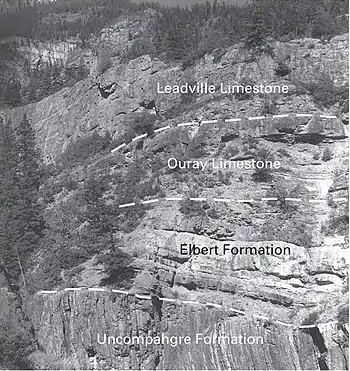Leadville Limestone
The Leadville Limestone is a Mississippian geologic formation in the western United States.[2] In Colorado, the upper part is oolitic limestone, while the lower part is primarily dolomite, and somewhat sandy beds indicate the bottom of the formation.
| Leadville Limestone | |
|---|---|
| Stratigraphic range: Carboniferous | |
 Silver-replaced gastropod in fossiliferous limestone (Leadville Limestone; Aspen, Colorado) | |
| Type | Formation |
| Sub-units | Castle Butte Member, Red Cliff Member, Yule Marble (informal) |
| Underlies | Molas Formation |
| Overlies | Chaffee Formation |
| Thickness | 220 feet (Marble Quadrangle, CO) |
| Location | |
| Region | Western U.S. |
| Country | United States |
| Extent | AZ, CO, NM, UT[1] |
| Type section | |
| Named for | Leadville, Colorado |

Outcrop in the Uncompahgre Gorge with key geological formations], including the Ouray Formation, Elbert Formation, and the Leadville Limestone
The formation is sparsely fossiliferous but contains many calcareous algae, Foraminifera (Endothyra), sponges, corals (Syringopora), Bryozoa, many brachiopods, gastropods (Bellerophon, Straparolus), Cephalopoda, fragments of ostracods, abundant fragments of crinoids, echinoid spines, and teeth of fish.[3]
A metamorphic facies of this formation is known as the Yule Marble and has been quarried for construction materials.
References
- Leadville, National Geologic Map Database, Geolex — Unit Summary. Last update: 6 August 2020
- Geologic map of the Marble quadrangle, Gunnison and Pitkin Counties, Colorado, Gaskill, D.L., and Godwin, L.H., 1966. USGS Geologic Quadrangle Map GQ-512. Map Scale: 1:24,000.
- Geology of Glenwood Springs Quadrangle and Vicinity, Northwestern Colorado, By N. Wood Bass and Stuart A. Northrop, 1963. GEOLOGICAL SURVEY BULLETIN 1142-J. pp. J26-J29.
This article is issued from Wikipedia. The text is licensed under Creative Commons - Attribution - Sharealike. Additional terms may apply for the media files.